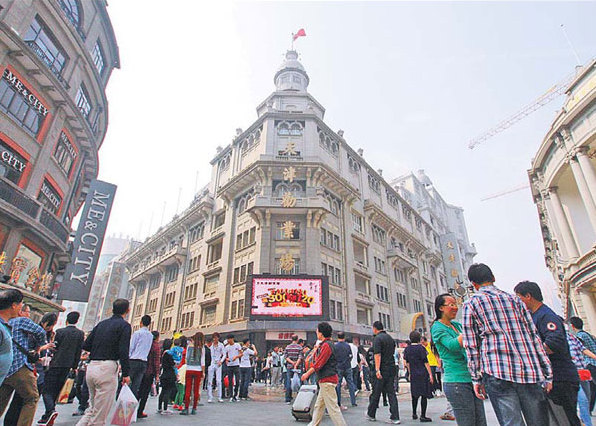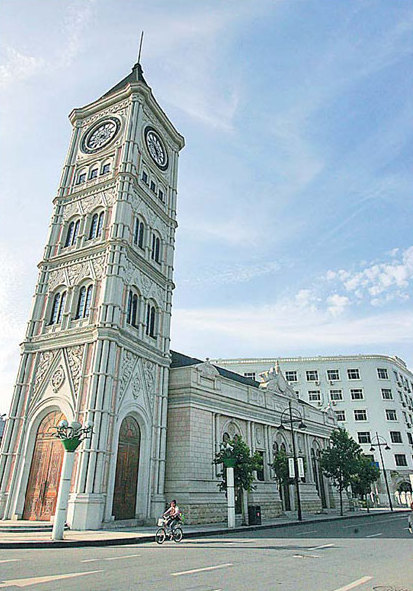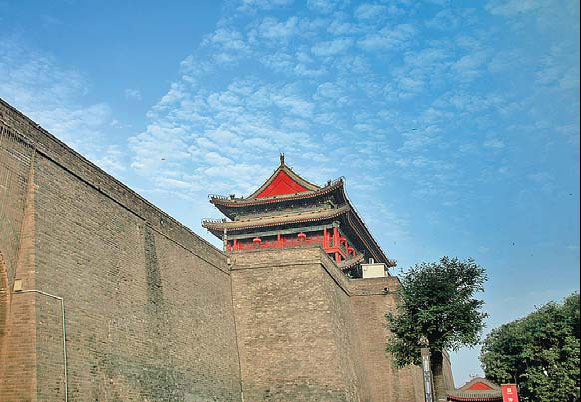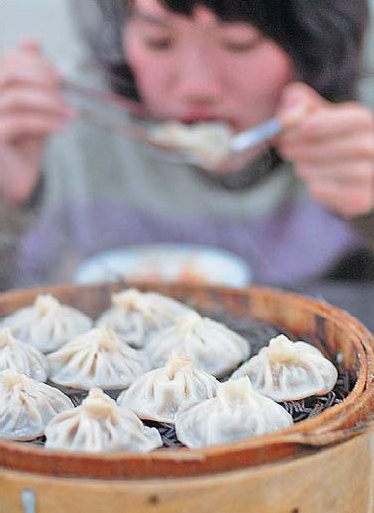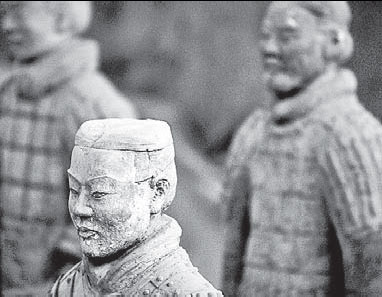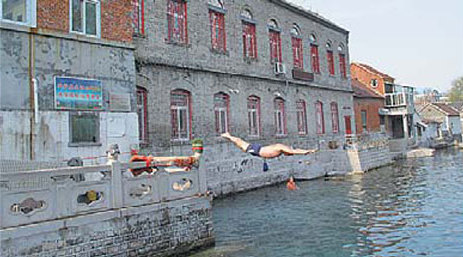Express excursion
Updated: 2013-04-05 07:44
By Mu Qian (China Daily)
|
||||||||
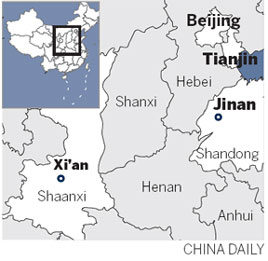
This Tomb Sweeping Day holiday, explore some of northern China cities accessible via high-speed trains from Beijing. Mu Qian gives you some tips.
With the rapid expansion of China's high-speed rail network, cities that were considered far from Beijing are now only a short ride away. Taking trains that run at speeds up to 350 km per hour, you will find China smaller than it used to be.
China already has the world's longest high-speed rail network, with about 9,300 km of routes in service. The fast and convenience of online ticket booking, and brand-new mall-style of high-speed rail stations make train rides enjoyable, in contrast to the dreadful image associated with Chinese railways in the past.
Take the chance this Tomb Sweeping Day holiday to explore some cities in northern China accessible via the high-speed train from Beijing.
|
Shopping area around Binjiang Road attracts big crowds during holidays. Ba Shen / For China Daily |
|
Italian Tourism Zone is located in the former Italian Concession. Jiang Baocheng / For China Daily |
Tianjin
Located on the fringe of Beijing, getting from the capital city to Tianjin is easy. It takes only half an hour for a high-speed train to cover the 130 km between Beijing South Railway Station and Tianjin Railway Station.
Note that there is also a train plying between Beijing and the newly built Tianjin South Railway Station, which is far from the city center and not the best stop for tourists.
Get a ticket to Tianjin Railway Station, located in the center of the city with a view of the scenic Haihe River.
Within walking distance from the station is the Italian Tourism Zone, a trendy area that was the former Italian Concession. It is supposedly the best-preserved quarter of Italian architecture outside Italy.
You will find restaurants, bars, museums and galleries housed in historic buildings in this area. Of special interest to some is the memorial of Liang Qichao (1873-1929), a scholar and reformist who played an important role in China's modern history.
The memorial consists of two neighboring buildings designed by Liang himself. One was his residence and the other his study also known as "Ice-Drinker's Studio".
There were once nine foreign concessions within Tianjin. Although Chinese people feel ambivalent about that history, the various buildings left from the time have now become the city's heritage.
Cross the Haihe River from the Tainjin Railway Station, and you are on the Jiefang Road, which used to be the location where Chinese and international financial institutions congregated in the late 19th and early 20th century.
HSBC, Standard Chartered, Citibank, Russo-Asiatic and many others used to be located here. Although the companies are no longer operational at the site, their original buildings make the road an open museum of architecture.
If time and budget allow it, stay a night at the Astor Hotel along Jiefang Road, which was built in 1863 and boasts the country's first lift. Or put up a night at the Peace Hotel on the quiet Dali Road, where Mao Zedong once stayed.
To see the Chinese side of Tianjin, go to the Gulou area or Ancient Cultural Street to shop for traditional handicrafts. Some of the well-known Tianjin snacks are baozi (steamed stuffed buns) and mahua (fried dough twist), found in the Food Street.
If you understand Mandarin, don't forget to go to a teahouse to watch a grassroots cross-talk performance, which is one of Tianjin's most famous specialties.
|
The well-preserved city wall bears witness to the glorious past of Xi'an. Zheng Zhong / For China Daily |
|
The Muslim Street is the best place to taste authentic Xi'an snacks like soup dumplings. Mai Tian / For China Daily |
|
Terracotta Warriors is the best-known site in the ancient city. Mai Tian / For China Daily |
Xi'an, Shaanxi province
Xi'an used to sound like a remote place from Beijing that is reachable only by air, but now the high-speed train takes you there within about five hours. If you get up early enough, you can even leave in the morning and arrive in Xi'an for lunch.
Xi'an is the capital of Shaanxi province, but more importantly, it is an ancient capital of China, having held the position under several of the most important dynasties in Chinese history, including Western Zhou (c. 11th century-771 BC), Western Han (206 BC-AD 24) and Tang (AD 618-907).
With more than 3,100 years of history, Xi'an is also the eastern terminus of the Silk Road and home to the Terracotta Army, which is the No 1 sight of the city.
The Bell Tower and Drum Tower, located at Xi'an's central axis, is a good area to stay in the city. Although the drum and bell no longer announce the official time, they give you a historical feeling.
The area is close to the Muslim Street, which is full of Muslim restaurants. You can taste authentic Xi'an snacks like soup dumplings and pita bread soaked in lamb soup, among others.
The Muslim Street is part of the Muslim Quarter of Xi'an, which came into being during the Tang Dynasty and basically remains intact.
In the heart of the Muslim Quarter is the Great Mosque of Xi'an, which, founded in 742, is one of the oldest and most renowned mosques in the country.
The mosque is completely Chinese in its construction and architectural style, except for some Arabic lettering and decorations, showing the efforts of Muslims to acculturate to the local culture.
A popular tourist site of Xi'an, the mosque still functions as a place of worship and you will see Chinese Muslims congregate to pray if you visit during prayer hours.
Xi'an contains hundreds of royal mausoleums and tombs from different dynasties. The city also has numerous ancient pagodas and is noted for its stele forest, which is housed in an 11th-century Confucian temple containing large stone tablets.
One of the easiest ways to soak up Xi'an's history is to take a walk on its well-preserved city wall, which was reconstructed in the 14th century and still surrounds the downtown area of Xi'an.
|
Zhuoying Spring is a popular site for Jinan residents to take a dip. Mu Qian / China Daily |
Jinan, Shandong province
Capital of Shandong province, Jinan is an unassuming city often neglected by tourists. But in fact, the city, located only 1.5 hours' train ride away, offers more than most tourists would expect.
Jinan is nicknamed "City of Springs" because of the many artesian springs it owns. The majority of the water features, many of which have been historically listed under the "72 Famous Springs", are concentrated in the downtown district and flow north to converge in the Daming Lake.
The Baotu Spring Park is the most popular tourist site of Jinan. Baotu means "jumping and leaping", because the water in the spring pool can be seen foaming and gushing, looking like a pot of boiling water.
According to records, the Emperor Qianlong (1711-99) of the Qing Dynasty (1644-1911) visited the site and declared it "the first spring under the heaven".
Although Baotu Spring is the most famous spring in Jinan, but it's the more down-to-earth small springs dotting the old districts that give Jinan its personality.
The late-Qing author Liu E described Jinan's cityscape in his novel The Travels of Lao Can as "Every family has spring water, every household has a willow tree".
Not every family has spring water now. But if you stay at the Pearl Spring Hotel, you can still enjoy the accompaniment of a spring in the courtyard.
Walk outside of the hotel and follow a small alleyway to the west, you will see traditional houses that seem trapped in time. Walk further on and suddenly you will find yourself in front of a big spring pool in the heart of the alley.
This is Zhuoying Spring, or more colloquially, the Wangfu Chizi ("Pool of the Prince's Household").
The combination of the pool and the houses beside it creates a picture similar to Venice.
People swim in the pool throughout the year, as the water is warm in winter and cool in summer.
If you don't feel like joining them, you can watch people play chess by the pool and enjoy the atmosphere of old Jinan.
When you are hungry, go to the nearby Furong Alley, where you will surely find something interesting in the restaurants and stalls that offer food from all over China. In the alley there is a small temple worshipping the god Guangong, in which you can also find a small spring.
In April when spring comes and willows turn green, it's a good idea to drink tea at a teahouse beside the Daming Lake, or take a boat trip to circle Jinan's moat, one of the few in China that still exist today.
It is not an overstatement to say that most activities in Jinan are likely to be associated with water.
Contact the writer at muqian@chinadaily.com.cn.

 'Taken 2' grabs movie box office crown
'Taken 2' grabs movie box office crown
 Rihanna's 'Diamonds' tops UK pop chart
Rihanna's 'Diamonds' tops UK pop chart
 Fans get look at vintage Rolling Stones
Fans get look at vintage Rolling Stones
 Celebrities attend Power of Women event
Celebrities attend Power of Women event
 Ang Lee breaks 'every rule' to make unlikely new Life of Pi film
Ang Lee breaks 'every rule' to make unlikely new Life of Pi film
 Rihanna almost thrown out of nightclub
Rihanna almost thrown out of nightclub
 'Dark Knight' wins weekend box office
'Dark Knight' wins weekend box office
 'Total Recall' stars gather in Beverly Hills
'Total Recall' stars gather in Beverly Hills
Most Viewed
Editor's Picks

|

|

|

|

|

|
Today's Top News
Boston bombing suspect reported cornered on boat
7.0-magnitude quake hits Sichuan
Cross-talk artist helps to spread the word
'Green' awareness levels drop in Beijing
Palace Museum spruces up
First couple on Time's list of most influential
H7N9 flu transmission studied
Trading channels 'need to broaden'
US Weekly

|

|
